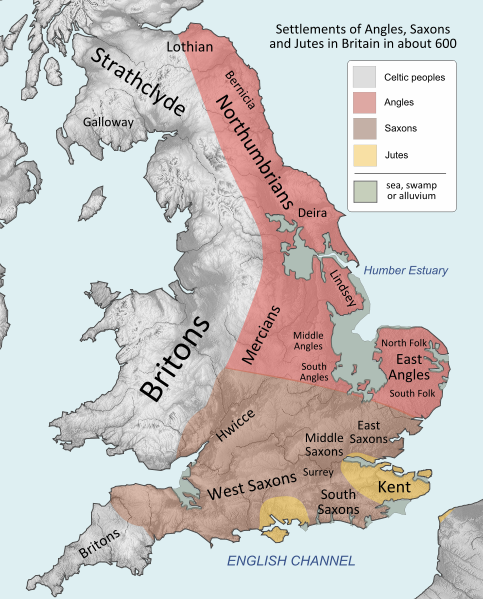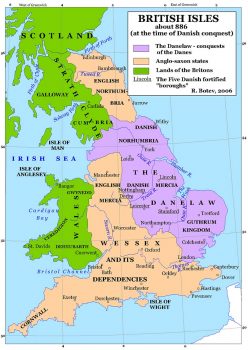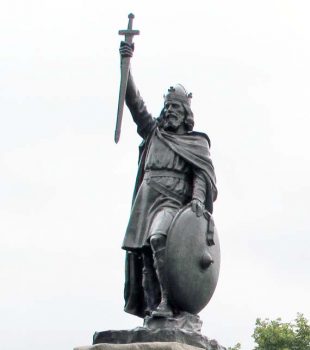Germanic pirates were raiding British shores as far back as the third century. These raids were purely for purposes of looting. They brought their families along and started settling during the fifth century. According to a legend the Briton king Vortigern invited the Germanic tribe of the Jutes, which settled in northern Jutland, to fight the Picts and Scots. The Jutes soon prevailed over the enemies of their overlord, but they soon turned against him too. They conquered Kent. Soon afterwards the invasion of other Germanic tribes started; for example: the Jutes settled in Kent, the Angles, coming from southern Jutland, settled in East Anglia, Northumbria and Mercia. The Saxons from northwestern Germany settled in Essex, Sussex and Wessex; the Frisian from northern Holland settled in the southern region of the isles.
The domicile, Celt population was forced into unfertile regions by the invaders. For example, a part of the Britons moved westwards and settled in the region that constitutes Wales today, and another part crossed the English Channel and settled in Bretania, which is named after them. The Anglo-Saxon language replaced Celtic, and polytheism came in place of Christianity.
The Germanic tribes formed little states on the isles, in the same fashion as the domicile population before them. It was known of twelve kingdoms in the seventh century. Nevertheless, due to the process of unification there were only five kingdoms left later: The Kingdom of Kent (the major faction until 616), East Anglia (until 617), Northumbria (until 659), Mercia (until 825) and Wesex (until the 12th century).
The Christianization of England
The Christianization of the Anglo-Saxons is rooted in two major causes, the missionary work of the Roman church and the missionary work of the monks who came from the monastery of Iona. In 597 Pope Gregory the Great sent a delegation under the leadership of Augustine to England to spread Christianity among the Angles and Saxons. Kent was the first kingdom that converted to Christianity. The reason for this was that the king of Kent, Æthelberht († 616) was married to a Frank princess, and she was a Christian. He granted Augustine the right to form a diocese in Canterbury. The king of Northumbria and Essex Edwin was the next king who converted to Christianity, since he married a princess from Kent. The Kentish princess brought a missionary with her, Paulinus, who formed a diocese in York. Finally the king of East Anglia also converted to Christianity.



The further spread of Christianity was temporarily hindered by the founder of Mercia – the pagan Penda. He allied with the Celtic king of Wales and conquered northern Northumbria, Wessex and Kent. This way Northumbria became isolated from Rome. King Oswald, which spent some times of his life in the monastery Iona, where he converted to Christianity, granted the monks from Iona the right to form another monastery on the island Lindisfarne. A massive process of Christianization started in Northumbria and in 655 Oswald defeated and killed Penda.
The Anglo-Saxons were converted to Christianity in the seventh century, although Christianity was not unified. The center of the Church was located in Canterbury for some, others deemed Iona the center. The twofold organization of the church, the friction between the Celtic and Roman churches, was mostly felt in Northumbria.Therefore the Northumbrian king Oswiu (Oswig) called for a great church synod in Whitby in 664. The majority of the synod, with the king on their side, choose Roman Christianity. The offended Scots and Irish left Witby. Soon after that their monks left England and retreated to their monastery in the Irish isles. Canterbury in England became an archdiocese and a new archbishop arrived from Rome, Theodore of Tarsus.
The dominance of Mercia and Norman invasion
The period in which Mercia was on the height of its power was under the kings Æthelred and Offa (787 – 796). King Offa united all Anglo-Saxon kingdoms under his rule. He left the rulers of Kent and Wessex in power, since they swore allegiance to him earlier. He raised a defensive wall against the Celt kingdom of Wales. He manufactured money, codified laws, and gave the Pope a tribute of one gold piece a day. The hegemony of Mercia was ended by Wessex.



From the ninth to the eleventh century England was invaded by Scandinavians which were known as the men from the north, Northman or Normans. The population called them Vikings and they were of Germanic descent. The early Norman attacks were raids. For example, in 787 Norman pirates raided the shores of Wessex, and in 793 they raided some monasteries in Ireland: Iona, Lindisfarne and Jarrow. In 850 the Danish fleet arrived at London and Canterbury over the Thames River. They plundered and continued to Mercia and Wessex where they were stopped by the king of Wessex. While the Norwegians were mostly active in Ireland and Scotland, the Danes were interested in the eastern region of England: Northumbria, East Anglia and Wessex. From the ninth century the Normans are not only raiding but also settling in England. In 870 the Danes overthrew the rulers of East Anglia and established their own kingdom. They conquered York six years later (876), a town in Northumbria, and Mercia was forced to pay tribute. Their further advance was stopped by the king of Wessex, Alfred the Great.
Alfred the Great (871 – 899)
Alfred the Great, the king of Wessex who reigned from 871 to 899, strengthened the state and was the person responsible for the emergence of national sentiments. From the day of his coronation to the danish invasion of Wessex (878), Alfred payed the Danes a tax, the so called “Lengeld“. Finally he decided to confront the oppressors and gathered an army. He defeated the danish king Guthrum in the battle of Edington (878) and made him accept the so called treaty of Wedmore. This treaty regulated the border between the so called lands of the danish law (Danelaw) and the lands of the king of Wessex. Wessex, Kent, a part of Mercia and London with the surrounding lands remained in the hands of Alfred.



By the tenth century his descendants reconquered all of the so called lands of the danish king. King Alfred was not only a soldier and politician. He loved the arts and literature, and he learned how to write in his ripe years. Alfred organized a school at his court, for the children of his court members. He supported the translation of Latin works into Anglo-Saxon. It is said that his influence sparked the interest in national history. Alfred used this period to strengthen his administration, the rule of law and the defenses of his kingdom. A series of fortifications or burhs was established; 33 are recorded in the Burghal Hidage, a document which dates from the reign of Edward, Alfred’s son. They were placed so that no settlement throughout Wessex was more than twenty miles from a fort which would be repaired and, if required, garrisoned by men of the locality. Although they were not completed at the time of the next Danish invasion in 892, their presence probably did much to dissuade the Danes from encroaching too far into Wessex itself. The Danish army did not withdraw from England until 896, but Alfred’s kingdom was rarely threatened as it had been in the 870s.
Alfred was not only the preeminent ruler of his time, being recognized as overlord of Mercia as well as King of Wessex, he was a man of considerable learning and scholarship. Between the years 892 and his death in 899, Alfred translated five Latin works into English, including Cura Pastoralis (Pastoral Care), by Pope Gregory the Great and Bede’s Historia Ecclesiastica. Alfred’s scholarship and the encouragement he gave to the use of Old English as a language of record also explain why he remained famous to succeeding generations of Englishmen: his contemporary biographer Asser recorded his life in glowing terms, and the Anglo-Saxon Chronicles which date from his reign are also keen to record his victories and virtues. But even allowing for a degree of propagandizing, Alfred deserves his reputation as one of the key figures in the political and cultural development of the English nation.
Danish kings as the rulers of England (1016 – 1042)
In 980 a new wave of danish pirates endangered the coasts of east England. Æthelred the Unready, the king of Wessex, descendant of Alfred, feared that these renewed attacks would spark rebellion among the conquered Danes in England. Therefore he organized gruesome mass killings of Danes while Denmark and Norway were waging war against each other (1002). The danish retaliation came one year later. By 1013 the Danes were again in control over the so called lands of the danish law, and they captured London in 1014. Æthelred fled to Normandy. The danish king Sweyn was named king of England. Sweyn died in the same year, and his land was divided among two sons: Harald was granted Denmark, Cnut was set as the ruler of Norway and England. In the meantime Æthelred returned from Normandy with his son Edmund Ironside. By 1016 there had been several bloody battles between Edmund and Cnut. Finally the warring sides came to an agreement. Edmund was granted Kent and the rest of England remained under Cnut. Edmund died shortly afterwards under unknown circumstances so Cnut was left as the sole ruler of England. Cnut the Great ruled from 1016. to 1035. He was the king of Denmark, Norway and England. His court was located in Winchester, and he deemed England as the center of his kingdom. He had good relations with the pope and Germany. This united kingdom did not last long after Cnut, his descendants ruled only for a short period.
Edward the Confessor (1042 – 1066)
In 1042 Edward was named as the king of England, he was also known as Edward the Confessor. He was a descendant of Alfred the Great. His father was Æthelred the Unready, his mother was Emma, the daughter of the Richard I, the duke of Normandy; she married Cnut upon the death of her husband. Edward spent his youth in Normandy, at the court of his uncle Richard I. He was a strange young man, who had grey hair early in his youth and who was overly religious. He didn’t know the language of his subjects when he started ruling, so he surrounded himself with people from Normandy. He left all state affairs to Godwin. He had no descendants.
